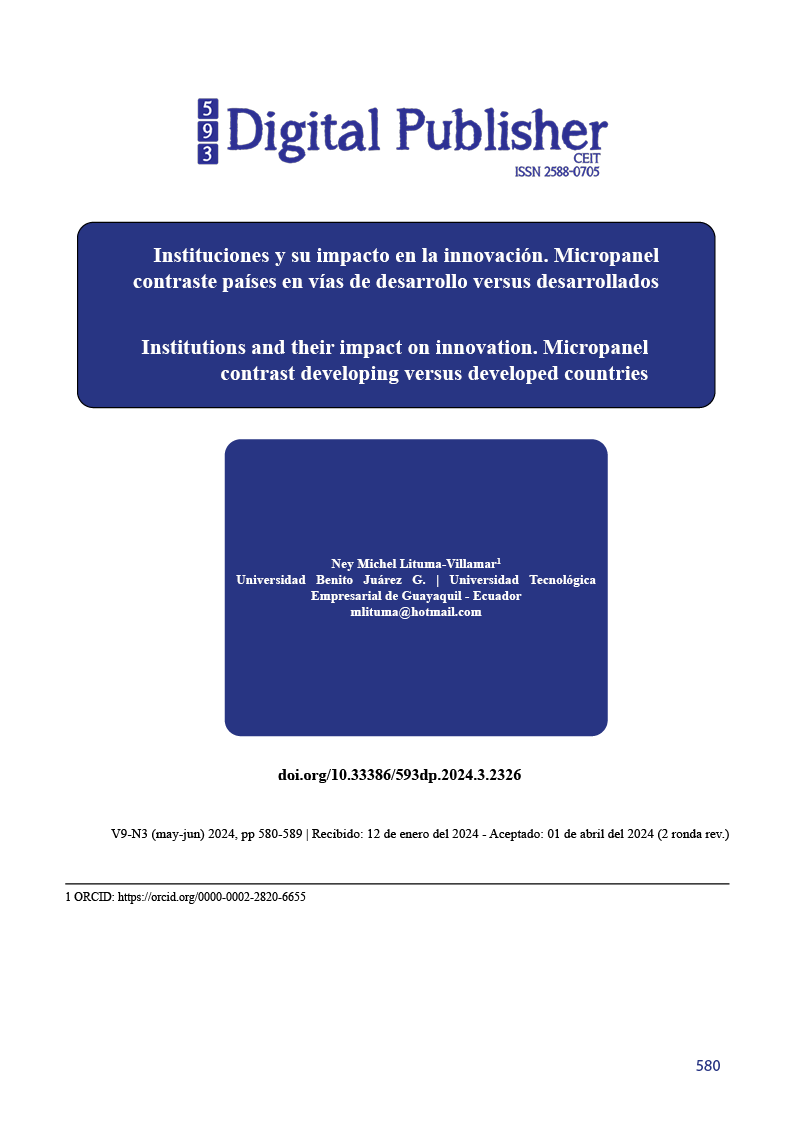Instituciones y su impacto en la innovación. Micropanel contraste países en vías de desarrollo versus desarrollados
Contenido principal del artículo
Resumen
La innovación es el camino de las naciones para el desarrollo económico y bienestar de sus ciudadanos, por lo que cualquier estudio que ayude a comprender de mejor manera su accionar reviste de gran importancia. Por regla general la innovación de un país se la caracteriza por los dólares invertidos en I&D, en la cantidad de marcas, patentes o artículos científicos, e igualmente, siempre es contrastada con indicadores tales como el PIB, la apertura comercial, entre otras, empero, ha sido poco estudiada bajo el parámetro de las “instituciones”. Otra brecha de conocimiento encontrada con la revisión de la literatura es la escasa producción de investigación del tema analizando a los países en vías de desarrollo. Por lo que este estudio tiene como objetivo determinar el impacto de la variable instituciones en la generación de innovación en países en vías de desarrollo y compararlos con los desarrollados. Esta investigación es de carácter correlacional, no experimental, basado en datos longitudinales del Índice Global de Innovación. Entre los hallazgos encontrados se distinguen que, si existe una correlación positiva entre innovación e instituciones, así mismo, se evidenció diferencias del impacto de la variable institución en la creación de innovación entre los dos diferentes grupos de países. Entre las limitantes del trabajo es sólo inferir diversas hipótesis acerca de los resultados sin profundizarlas y su originalidad radica en el uso del método heurístico para encontrar un enfoque novedoso en la conceptualización de las variables.
Descargas
Detalles del artículo

Esta obra está bajo una licencia internacional Creative Commons Atribución-NoComercial-CompartirIgual 4.0.
1. Derechos de autor
Las obras que se publican en 593 Digital Publisher CEIT están sujetas a los siguientes términos:
1.1. 593 Digital Publisher CEIT, conserva los derechos patrimoniales (copyright) de las obras publicadas, favorece y permite la reutilización de las mismas bajo la licencia Licencia Creative Commons 4.0 de Reconocimiento-NoComercial-CompartirIgual 4.0, por lo cual se pueden copiar, usar, difundir, transmitir y exponer públicamente, siempre que:
1.1.a. Se cite la autoría y fuente original de su publicación (revista, editorial, URL).
1.1.b. No se usen para fines comerciales u onerosos.
1.1.c. Se mencione la existencia y especificaciones de esta licencia de uso.
Citas
Acs, Z., Anselin , L., & Varga, A. (2002). Patents and innovation count as measures of regional production of new knowledge. Research Policy, 31(7), 1069-1085. https://doi.org/10.1016/S0048-7333(01)00184-6
Arellano, M., & Bover, O. (1990). La Econometría de los Datos de Panel. Investigaciones Económicas, 14(1), 3-45.
Beltrán, A., & Castro, J. F. (2010). Modelos de datos de panel y variables dependientes limitadas: teoría y práctica. Universidad del Pacífico.
Bjørnskov, C., & Rode, M. (2020). Regime types and regime change: A new dataset on democracy, coups, and political institutions. The Review of International Organizations , 15, 531–551. https://doi.org/10.1007/s11558-019-09345-1
Cabrera, P., Mares, I., & Moreno, Y. (10 de noviembre de 2023). Método Heurístico. Obtenido de Blog en wordpress del Instituto Universitario Politécnico "SANTIAGO MARIÑO": https://analisisheuristicos.wordpress.com/metodo-heuristico/
Cai, F., & Zhang, X. (2017). Structural Reform for Economic Growth. The Australian Economic Review, 50(4), 450-459. https://doi.org/10.1111/1467-8462.12248
Cheibub, J. A., Gandhi, J., & Vreeland , J. R. (2010). Democracy and dictatorship revisited. Public Choice, 143, 67–101. https://doi.org/10.1007/s11127-009-9491-2
Cobacho, M. B., & Bosch, M. (23 de mayo de 2012). Contrastes de hipótesis en datos de panel. Obtenido de Repositorio de Universidad de Cartagena : https://tinyurl.com/yscu9d32
De la Rosa, C. (29 de junio de 2016). Introducción a modelos de datos de panel. Obtenido de Repositorio digital [tesis de grado, Universidad de Valladolid]: https://tinyurl.com/yrqd4l6x
Duan , D., Zhang, Y., Chen, Y., & Debin . (2019). Regional Integration in the Inter-City Technology Transfer System of the Yangtze River Delta, China. Sustainability, 11(10), 2941. https://doi.org/doi.org/10.3390/su11102941
Flanagan, K., Uyarra, E., & Laranja, M. (2011). Reconceptualising the ‘policy mix’ for innovation. Research Policy, 40(5), 702-713. https://doi.org/10.1016/j.respol.2011.02.005
Frantzen, D. (2000). Innovation, international technological diffusion and changing influence of R&D on productivity. Cambridge Journal of Economics, 24, 193-210.
Furman, J. L., Porter , M., & Ster, S. (2002). The determinants of national innovative capacity. Research Policy, 31(6), 899-933. https://doi.org/10.1016/S0048-7333(01)00152-4
German-Soto, V., Soto-Rubio, M., & Gutiérrez-Flores, L. (2021). Innovación y crecimiento económico regional: evidencia para México. Problemas del Desarrollo. Revista Latinoamericana de Economía, 52(205), 145-172. https://doi.org/10.22201/iiec.20078951e.2021.205.69710
Grande, E., & Peschke, A. (1999). Transnational cooperation and policy networks in European science policy-making. Research Policy, 28(1), 43-61. https://doi.org/10.1016/S0048-7333(98)00099-7
Griffith, R., Redding, S., & Van Reenen, J. (2001). Mapping the two faces of R&D: productivity growth in a panel of OECD industries. CEPR Discussion Paper 2457.
Lituma, N. M., Zambrano, J. C., & Gordillo, I. P. (2023). Correlation Between Innovation Inputs and The Economic Growth of Countries. Scientific Journal of Applied Social and Clinical Science, 3(26), 1-14. https://doi.org/10.22533/at.ed.2163262303102
Novales, A. (enero de 2016). EstimaciÛn de modelos no lineales. Obtenido de Repositorio Universidad Complutense: https://tinyurl.com/yuorrfbr
OECD. (22 de octubre de 2018). Oslo Manual 2018 Guidelines for Collecting, Reporting and Using data on Innovation. https://doi.org/10.1787/9789264304604-en
Popper, K. (2005). The logic of scientific discovery. New York: Routledge,.
Popper, K. (2020). The open society and its enemies. New York: Routledge,.
Stock, J. H., & Watson, M. M. (2012). Introducción a la Econometría. Pearson. Obtenido de https://tinyurl.com/ym2eqbac
Varsakelis, N. C. (2001). The impact of patent protection, economy openness and national culture on R&D investment: a cross-country empirical investigation. Research Policy, 30(7), 1059-1068. https://doi.org/10.1016/S0048-7333(00)00130-X
Varsakelis, N. C. (2006). Education, political institutions and innovative activity: A cross-country empirical investigation. Research Policy, 35(7), 1083-1090. https://doi.org/10.1016/j.respol.2006.06.002
Wang, Q.-J., Feng, G.-F., Wang, H.-J., & Chang, C.-P. (2021). The impacts of democracy on innovation: Revisited evidence. Technovation, 108(102333). https://doi.org/10.1016/j.technovation.2021.102333
WIPO. (2020). The Global Innovation Index. Geneve: World Intelectual Property Organization.
WIPO. (2021). Global Innovation Index 2021. Tracking Innovation through the COVID-19 Crisis. World Intellectual Property Organization, Geneva 20, Switzerland. https://doi.org/10.34667/tind.44315
WIPO. (2023). Global Innovation Index 2023: Innovation in the face of uncertainty. Geneva. https://doi.org/10.34667/tind.48220
Xiong , A., Xia , S., Ye, Z. P., Cao , D., Jing , Y., & Li, H. (2020). Can innovation really bring economic growth? The role of social filter in China. Structural Change and Economic Dynamics, 53, 50-61. https://doi.org/10.1016/j.strueco.2020.01.003
Zachariadis, M. (2003). R&D, Innovation and technological progress: a test of the schumpeterian framework without scale effects. Canadian Journal of Economics , 36 (3), 566-686.
Zeng, J., Liu, Y., Wang, R., & Zhan, P. (2019). Absorptive capacity and regional innovation in China: an analysis of patent applications, 2002 - 2015. Applied Spatial Analysis and Policy, 12, 1031–1049.


